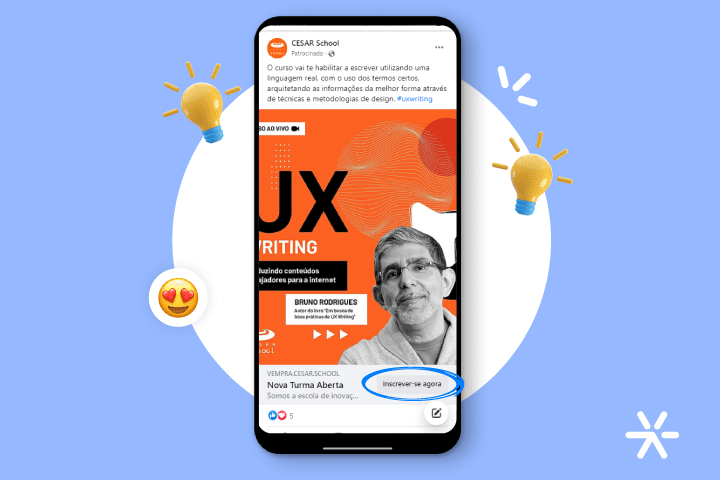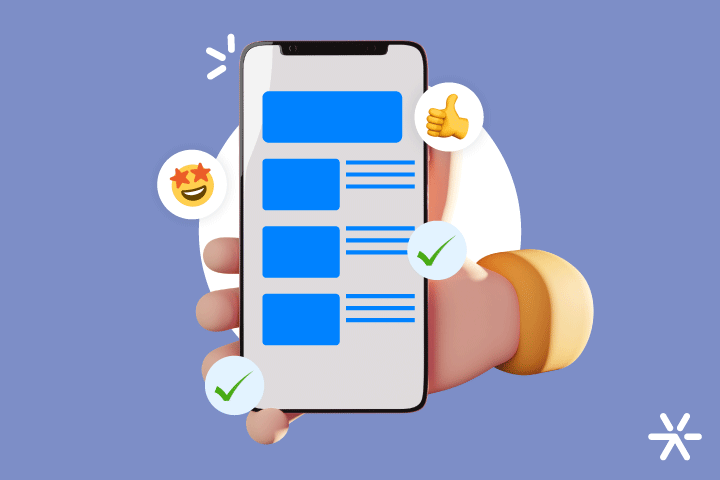Examples of SaaS companies that generate leads: What do They Do
Today, I’d like to take a slightly different approach from what we’re used to here on the blog. Let’s explore some examples of SaaS companies and try to understand what they do to generate leads.
Often, articles on blogs struggle to dive too deeply into practical matters, as conducting a detailed analysis of another brand’s lead generation structure is a complex task.
Not complex in terms of execution, mind you, but complex to fit into other articles without detracting from their main message.
When you read an article about email marketing, for example, you’re not looking to learn all about the analyzed brand’s inbound strategies. You’re there for email marketing.
In today’s article, we’ll consolidate all the references we have here at Leadster and aim to deliver a more in-depth analysis of the key marketing techniques used by SaaS companies.
First, we’ll discuss the analysis methodology, and then I’ll present a list of major Brazilian SaaS companies (or those operating in Brazil) and detail their actions and strategies.
Shall we?
Understanding the Methodology — How to Identify and Analyze SaaS Companies

First, let’s talk about the methodology for this article. There are two main points to address.
First, the capture methodology — how did we find the examples of SaaS companies to analyze?
This part was the easiest. And as a marketing enthusiast, you’ll probably agree with me: to find examples, all you need to do is open your email inbox.
SaaS companies worth analyzing must at least be doing this: getting people into their nurturing flows.
Of course, we can’t analyze every SaaS company because we’re not leads for all of them. But we are for most that deal with marketing.
In addition to this straightforward analysis, we’ll also select some of the best in the market — the most well-known, established, and successful companies.
Now for the analysis method — what exactly are we trying to understand?
We’ll divide the article into a few categories. Instead of reviewing every aspect of each company’s work, we’ll examine general actions and identify which companies execute them most effectively.
These categories relate to the core marketing efforts and the actions being implemented by the analyzed SaaS companies.
Simple, right? This way, we can assess both the companies and the most important strategies within inbound marketing, outbound marketing, and content marketing.
Does the research methodology make sense? If so, let’s dive into the analysis!
Examples of SaaS Companies Generating Leads Every Day

Before diving into the analysis, let’s outline the companies we’ll be looking at throughout this article.
It’s worth noting again that we won’t be dissecting every aspect of these companies’ strategies. That would require a much deeper study — a true benchmark.
While conducting such a benchmark would be great, we lack sufficient data to definitively inform you about all the key aspects worth analyzing.
Thus, it would be somewhat irresponsible to attempt an overly detailed analysis. We might inadvertently mislead you.
With that said, here are the companies we’ll analyze in this article:
- Conversion
- Resultados Digitais
- HubSpot
- VTEX
- Contabilizei
- Agendor
- TOTVS
- Pipefy
- Conta Azul
- Leadster
You’ll see several screenshots, examples, and some statistics on paid and organic traffic — especially keywords and visitor volume — for all of them.
But don’t worry: there’s also a benchmark. However, it’s a responsible one — our own.
At the end of 2023, we conducted an open benchmark, showcasing all our data and explaining what worked and what didn’t.
There are many details for you to follow, so it’s a good idea to download Leadster’s Open Benchmark while reading this article, comparing the data and actions with what worked and what didn’t for us.
Click on the banner below to access it. Then we’ll continue our work:
What Do SaaS Companies Do to Generate Leads and Convert Sales?
Now, let’s dive into the exploratory part of the article! There’s a lot to discuss about the strategies these brands employ, but first, we need to define the scope of our discussion.
Lead generation is a subset of inbound marketing, which is the most widely used digital marketing methodology today.
However, inbound marketing is facing a challenge: it needs to adapt quickly, as the lead conversion landscape is gradually but significantly changing.
We’ll focus on lead generation, specifically:
- Strategies for attracting visitors to websites;
- How conversions happen on those websites.
These two elements alone will provide great insight into how lead generation works. Each item includes various sub-items that define the scope of the work.
At the end, we’ll include a few extra resources that are also worth exploring. But for now, let’s stick to these main points about lead generation.
Ready? Let’s get to work!
Attracting Visitors to SaaS Websites — How Do They Do It?
Among all the companies analyzed, it’s clear that the most well-developed strategies for attracting new website visitors are, by far, organic traffic and paid media.
Analyzing these companies’ paid media efforts is quite challenging. You can, for instance, see their recent Meta ads via the Ad Library.
However, this type of analysis is very basic — you can’t see exact numbers, nor can you view ads from very long timeframes.
Therefore, our analysis will focus primarily on organic traffic and the content structures of the analyzed brands.
Let’s start with the basics:
Primary Content Channels for SaaS Companies
Content channels are any platforms where material can be produced.
The format of the material or the main way it’s produced doesn’t matter here. What’s important is that the audience transitions from the content to the site.
Even that goal is somewhat rigid. What truly matters is engagement with the brand, which can happen on a larger or smaller scale depending on the channel.
For lead generation, one channel stands out: blogs.
However, in terms of interaction, other channels have a clear advantage. Let’s delve into these aspects below.
Blogs
Our analysis showed that the most common way to attract visitors to a site today is through blogs aimed at generating leads.
This isn’t the only way to generate leads and foster brand interaction — far from it. But it’s the most widely used and reliable way to drive traffic to a site.
The first brand we analyzed was HubSpot. Let’s start by examining their overall organic traffic, according to Semrush:

Here, we see that their organic traffic exceeds paid traffic by more than 100 times! But what else can Semrush tell us about their efforts?

Interestingly, HubSpot has over 3,400 keywords ranking in Google’s top three positions.
Clearly, blogging is their primary strategy for traffic generation.
Despite the advances in Google’s generative AI, which poses a challenge to SEO and organic traffic strategies, it’s still evident that this is the main channel for driving visitors.
And that’s just HubSpot. Let’s quickly analyze Agendor, which has over 5,000 keywords in positions 1-3:

Or Dinamize, with 586 keywords:

Both have hundreds of thousands of visitors coming through organic traffic. There’s no doubt that SEO is a critical tool for driving site visitors.
YouTube
This doesn’t mean that blogs are the only visitor acquisition channel for HubSpot. Far from it.
The thing is, blogs are clearly a major content channel due to the high volume of indexed keywords on Google.
Looking at HubSpot’s recent videos, we see something quite different:
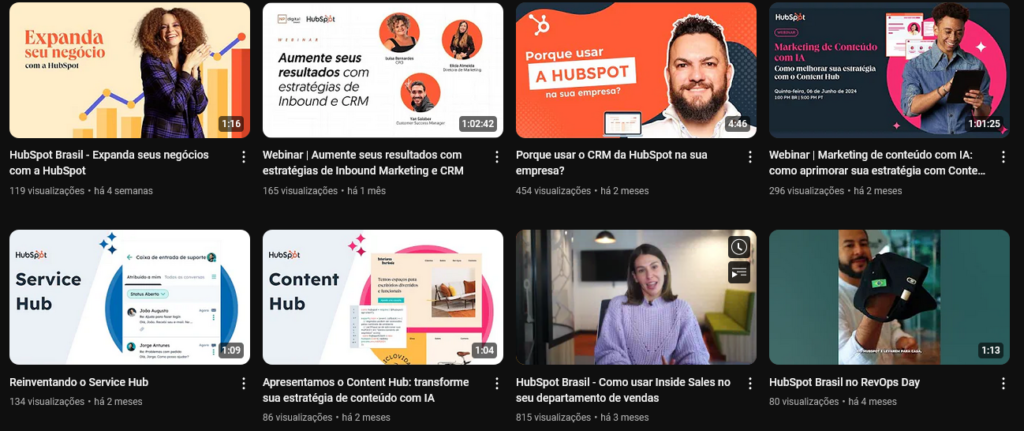
These are recent videos, so it’s normal for them not to have many views yet. But let’s go further and check videos that have been up for a year:
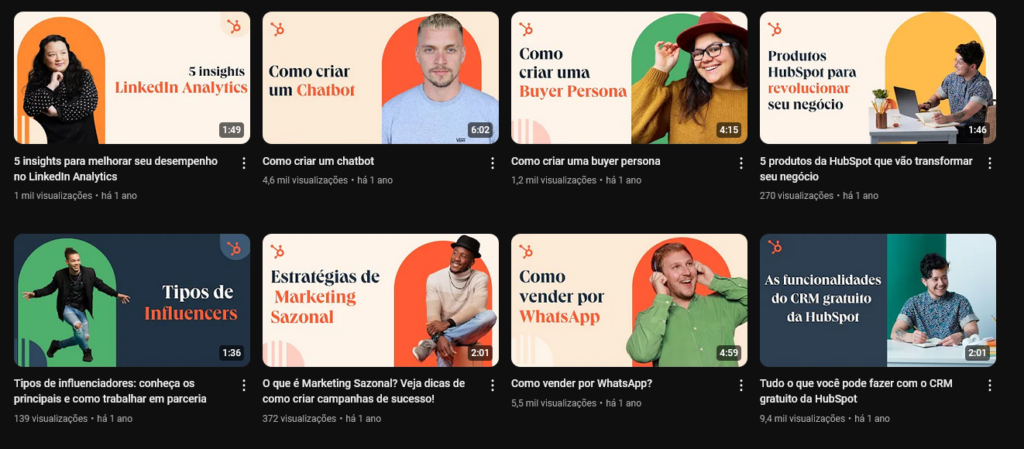
The most views a single video has garnered is 10,000 — over an entire year.
The issue to analyze here is slightly different, though. We need to understand that SaaS companies have several content channels — that much is clear.
But what are the goals for each content channel? Blogs have a very clear goal: to generate visitors and convert them into leads.
But what about YouTube? In addition to generating visitors, it also aims to generate engagement with the brand.
And in this regard, YouTube easily surpasses blogs. Take a look at the list of comments on one of their videos:

In blogs, you’ll rarely see comments. This is true for any brand. Large brands may get one or two comments per month on their articles, while smaller brands often receive more spam than real comments from people.
These comments are standard on all HubSpot videos, as well as several other brands.
In this case, it’s clear that YouTube outperforms blogs when it comes to interaction. But there’s still a type of content that brings even more interaction: social media.
Let’s analyze them now:

Social Media
If YouTube is great for interactions, Instagram is outstanding. Actually, it’s simply amazing.
One of the brands we analyzed throughout this article is Contabilizei. It’s a “small” brand compared to others, but that’s exactly the point we want to make here.
Smaller companies can produce content and achieve good engagement results even with fewer followers than larger ones.

Take this example. The number of likes that Contabilizei received on this post is relatively small, but it had over 10% engagement — 12 people commented.
The number might seem small, but we need to understand that Contabilizei has five times fewer followers than HubSpot, for example. And three times fewer than Resultados Digitais.
Speaking of RD, take a look at this post:

It announces Juliette as one of the participants in RD Summit 2024, and it received almost 500 comments.
This is quite common across all the brands we analyzed: interaction on Instagram is the highest among all the channels analyzed. But at the same time, it also comes with some special needs.
The main one is impact. Basic content doesn’t generate much engagement. This is the opposite of YouTube, for example — there, basic content gets a lot of attention and receives many comments.
What we need to understand for lead generation, though, is that the work is much more challenging on these channels than it is on a blog.
On a blog, the reader is already on the site and has easy access to CTAs. On these other channels, the CTA is “hidden” in the bio or video description.
And speaking of this, now we need to talk about the conversion opportunities available on these brands. How do they generate leads in practice? Let’s figure it out together:
How SaaS Companies Generate Leads
Now we understand the most commonly used channels by SaaS companies to generate visitors to their websites.
But generating these visitors has a very clear purpose: converting them into leads.
The conversion process is vast and difficult to expose. Many of the processes for the brands we’ll analyze are proprietary.
The simpler methods are easy to understand and apply. But the more complex ones are kept under lock and key.
The fact is that there isn’t much secret when most of the work involves a touchpoint between the visitor and the brand.
Let’s analyze these touchpoints to understand at least how the lead generation process begins.
Let’s go:
Chatbots
Chatbots are powerful tools for lead generation, used by the more innovative and marketing-focused brands among those we analyzed.
Here’s an example from RD Station:

When you enter RD’s website or any of their subdomains, there’s always a chatbot waiting for you with a personalized approach.
And this is the home page chatbot. Look at how interesting their flow is. Go to the website and come back quickly. But I’ll leave the transcription right below:
🤖 RD: Hi! What would be nice today? Learn more or try it out in practice? 🤩
🤓 Me: I want to try what I’ve learned in practice
🤖 RD: Which product would you like to know more about?
🤓 Me: RD Station Marketing
🤖 RD: Cool, before we continue, does your company have a website?
🤓 Me: Yes
🤖 RD: Great! Having a website is the first step! How many employees does the company have? 🤓 Me: Over 200
🤖 RD: Thank you. If the connection drops, what’s your email so we can follow up?
How interesting! This flow is really brilliant. The information it gathers from the visitor is fantastic. In just over 10 seconds, it’s possible to generate a qualified lead.
In this case, RD’s chatbot captured:
- Which product I was most interested in;
- That my company has a website;
- That my company has over 200 employees;
- My email.
All these steps served just one purpose: to gather my information and register my interest in the product.
If I provide my email there, I will immediately enter RD Station’s personalized nurture flow, aimed at the middle and bottom of the funnel.
But if I take another path, I’ll still receive emails in a different nurture flow, designed for the top of the funnel.
Chatbots win in versatility compared to other methods, as they offer personalized CTAs based on the page the user is accessing.
And with Leadster, you also benefit from the power of ChatGPT directly in the conversation, saving you time in developing these flows.
Pop-up CTAs
Another very common practice in lead conversion is using pop-ups as CTAs.
Here, you’ll find pop-ups in several forms:
- Exit pop-ups: which only appear when the user is about to close the tab;
- Scroll pop-ups: which appear after a certain amount of scrolling on a page;
- Static pop-ups: which are fixed in a specific position on the website. These are banners. Banners can appear in various positions on a page;
Among many other types of pop-ups. Below, you can see an example of an exit pop-up from Contabilizei:
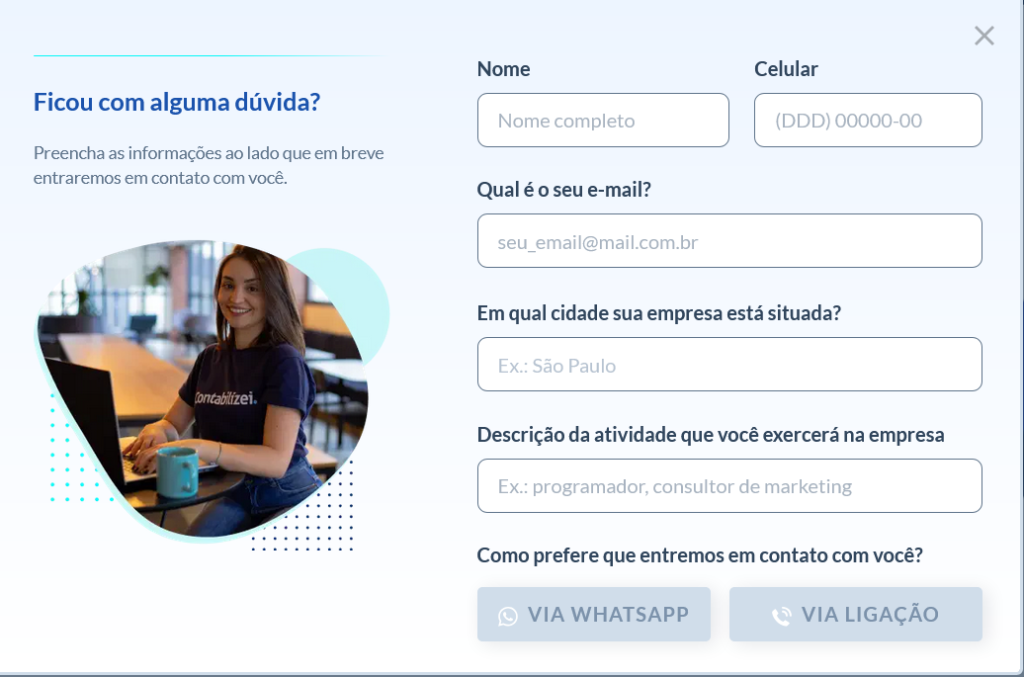
Notice the big difference that a pop-up has compared to a chatbot.
This is just one of its appearances, of course. Other types of pop-ups can take you to another page to complete your conversion into a lead.
In some cases, they direct you straight to the sales page and offer you a free product trial.
A chatbot can do all this while presenting lead qualification questions in a more friendly way and without relying so much on forms.
Direct Capture on the Home Page
Another way to capture leads is through direct capture on the home page.
It’s like a static pop-up, but it’s friendlier than a banner and interactive, allowing immediate conversion.
Here’s an example from Agendor:
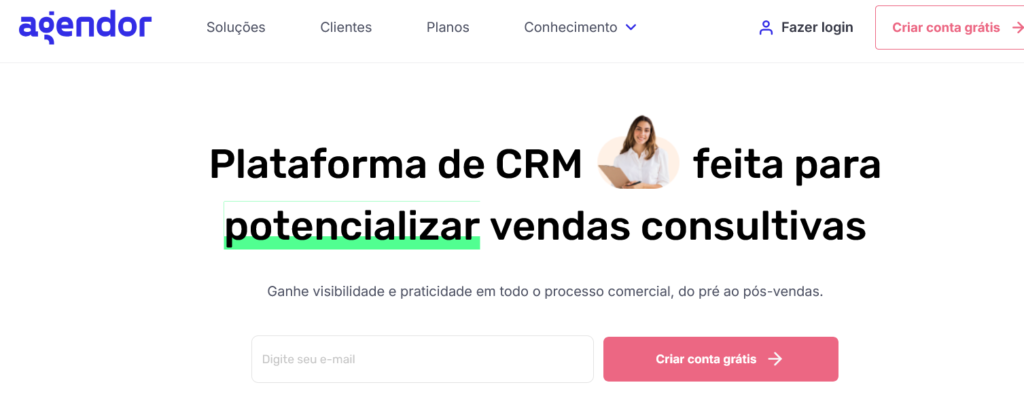
Here, the conversion offer is to create a free account, which is the same as offering a free product trial.
It’s worth mentioning that product trials are the main goal of SaaS marketing in general, governed by Product Led Growth. The linked article goes into much more detail on this, and it’s worth reading.
This is a very interesting model because it keeps the conversion opportunity in the spotlight while not interrupting the users.
Pop-ups carry interruption in their very name. You’re browsing calmly when suddenly — pop! — a form appears like a Pokémon.
Contact Page with a Form
There’s also the classic method, the one we’re all used to seeing on all types of websites, not just SaaS ones.
Here, we’re talking about a contact page that opens after the visitor clicks “Contact Us” or “Request a Quote.”
Here’s an example from VTEX:

It’s a separate page, organized, with an introductory text and form fields to fill in.
This type of conversion opportunity is the most common because it’s the easiest to implement on your website.
In fact, the page is even included in most development packages offered by agencies.
But at the same time, it has a characteristic that places it among the worst ways to generate leads on your site: the visitor has to find it.
All the other solutions we’ve seen here are “automatic.” They appear to the user without being asked for, some in a subtle way, others more interruptively.
The contact page is the most “polite” way of making the conversion, offering the lead full control.
But at the same time, it’s the least effective method since it doesn’t immediately catch the eye when someone accesses the website.
Dynamic Pricing and Free Trial
There is also another method worth mentioning: dynamic pricing and the pricing page itself as a way to capture leads.
It’s important to understand, when analyzing these lead generation strategies, that both are applied as extras — usually, websites use them together with one (or several) of the strategies mentioned above.
First, dynamic pricing. This technique is used on SaaS product pricing pages, altering the price according to the user’s needs.
Take a look at this example from Leadster International:
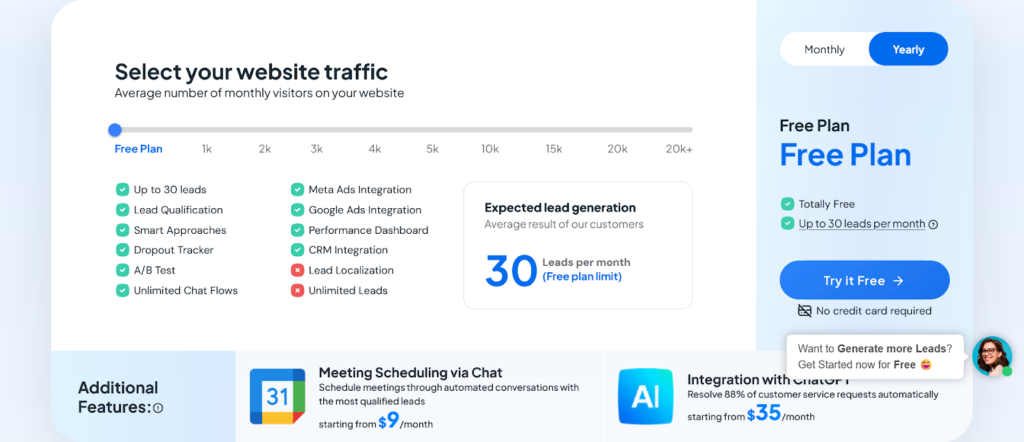
Here, based on the amount of traffic the person has on their site, they will receive a personalized offer with a different price.
This is a way to create greater interaction with your pricing, which is also related to lead qualification.
The free plan is always offered on SaaS pricing pages. This is a way to aim for the best possible conversion — qualified by the product.
Do you have a SaaS company and are wondering what the best way to generate leads is?
From reading the article, it’s clear that there are various ways to generate them, each more interesting than the other. And many brands use several of these methods in different possible ways.
If you want to start generating leads now, the best way is to begin with the simplest: a chatbot.
With Leadster, you won’t need to make any changes to your website’s front end, as an analyst + an IT professional can easily install the tool.
And the chatbot is, among all the alternatives we analyzed, the one with the highest customization potential. And with our ChatGPT feature, you don’t need to spend days customizing message by message.
Test it today by clicking the link below. Thank you for reading, and we’ll see you in the next article!




